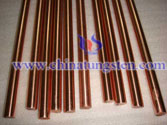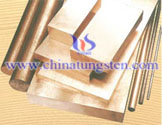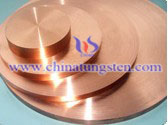Chromium Copper
What is chromium copper alloy?
Chromium copper alloy are high copper alloys, containing 0.6 to 1.2% Cr. The chromium copper alloys are used for their high strength, corrosion resistance and electrical conductivity. The chromium copper alloys are age harden able, which, in this case, means that a change in properties occurs at elevated temperature due to the precipitation of chromium out of the solid solution. The strength of fully aged chromium copper is nearly twice that of pure copper and its conductivity remains high at 85% IACS, or 85% that of pure copper. These high strength alloys retain their strength at elevated temperatures. The corrosion resistance of chromium copper alloys is better than that of pure copper because chromium improves the chemical properties of the protective oxide film. Chromium copper alloy has excellent cold formability and good hot workability. It is used in applications such as resistance welding electrodes, seam welding wheels, switch gears, cable connectors, circuit breaker parts, molds, spot welding tips, and electrical and thermal conductors that require strength. Chromium copper alloy are designated as UNS C18050 through C18600, the cast alloys are C81400 through C81540.



Chromium Copper Alloy Properties
Chromium copper alloy is a heat treatable copper alloy offering good electrical conductivity, resistance to softening at elevated temperatures and good strength and hardness. This combination of properties makes C18200 one of the preferred resistance welding electrode materials for a variety of applications. Nominally composed of 99.1% copper and 0.9% chromium, this heat treatable alloy can be brought to its softest condition by annealing it at 1000°C (1850°F) for one-half hour at temperature, then rapidly quenching it in water. In this annealed condition, the alloy is ductile and easily formed, and has an electrical conductivity of about 40% IACS.
The age hardening reaction occurs because the solid solubility of chromium in copper decreases as the temperature decreases. The structure of slow cooled chromium copper is a two phase mixture of chromium and alpha copper. Superior mechanical properties are achieved by fast-cooling the chromium copper alloys from the annealing temperature, so the chromium remains in a supersaturated solid solution with the copper. Followed by an aging treatment where the chromium precipitates from the solid solution forming a very fine dispersion of precipitates in the matrix. The microstructure of a quenched or quickly cooled chromium copper alloy appears similar to that of the unalloyed copper. A fast cool prevents the chromium from precipitating out of the solid solution, so the resulting cast structure consists of a single phase alpha copper structure. The first material to solidify is pure copper, followed by a eutectic mixture of alpha and chromium. The alpha and chromium eutectic material forms a lamellar structure in the interdendritic regions. The microstructure of the wrought alloy consists of equated, twinned grains of alpha copper solid solution. Typically allows are cooled rapidly so the chromium remains in alpha copper solid solution. The tempering treatment allows the chromium to precipitate out of solution forming a dispersion of chromium precipitates throughout the matrix. The chromium precipitates, or hardening precipitates, can be very fine and may not be visible at low magnifications.
Chromium Copper Alloy Applications
Resistance welding machine electrodes, seam welding wheels, electrical switch gear, electrode holder jaws, cable connectors, current carrying arms and shafts, circuit breaker parts, arcing and bridging parts, grid side rods in electron tubes, molds, spot welding tips, flash welding electrodes, electrical and thermal conductors requiring greater strength than copper, switch contacts.
Any feedback or inquiry of Tungsten Copper Alloy Products please feel free to contact us:
Email: sales@chinatungsten.com
Tel.: +86 592 512 9696 ; +86 592 512 9595



